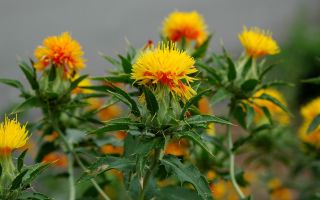Content
- 1 What does safflower look like and where does it grow?
- 2 Safflower composition
- 3 Why is safflower useful?
- 4 Preparation and application methods
- 5 Application in traditional medicine
- 6 Slimming application
- 7 Application in cosmetology
- 8 Cooking applications
- 9 Contraindications to the use of safflower
- 10 Collection and procurement
- 11 Conclusion
The beneficial properties of safflower petals are used in the treatment of diseases, for weight loss and in cosmetology. Before using raw materials, you must carefully study its features.
What does safflower look like and where does it grow?
Dyed safflower, or American saffron (Carthamus tinctorius), is an annual or biennial plant from the Astrov family. It has a straight, branched stem with a glossy whitish skin, the leaves of the grass are large, oblong-lanceolate, with a solid, but slightly prickly edge.
In mid-summer, dye safflower produces tubular buds with red, orange, or yellow petals. Flowers are collected in small baskets. By the beginning of autumn, it bears fruit - shiny white achenes of an oval-tetrahedral shape.
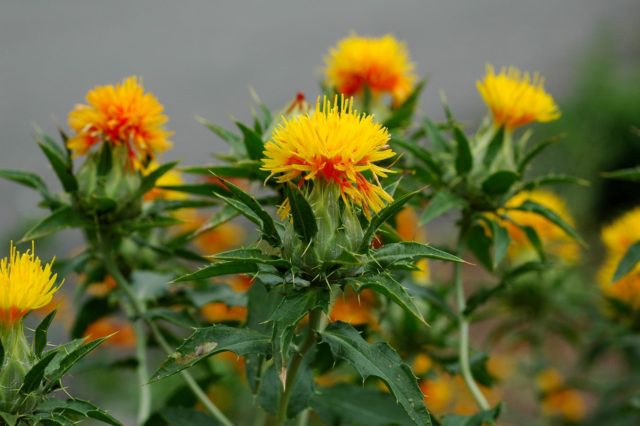
Dyeing safflower is widespread in South America, Africa, Spain, Egypt and China, as well as in the United States. You can meet him in the wild in the Crimea, the Caucasus, in the Kharkov and Kursk regions, in Turkmenistan.
Safflower composition
Photos of the safflower plant and its application are of interest due to the fact that the seeds and petals have a very rich composition. Raw materials contain:
- ascorbic acid;
- starch;
- iron and magnesium;
- vitamins A and K;
- tocopherol;
- oleic and palmitic acid;
- coloring pigments;
- cardamine and cardamidine;
- isocartiamine;
- stearic and linoleic acids.
When applied carefully, dye safflower petals and products based on them have a beneficial effect on the body and improve well-being.
Why is safflower useful?
Dyeing safflower and its petals are used in folk medicine for a wide range of diseases. In particular, a medicinal plant:
- improves intestinal peristalsis and helps normalize microflora;
- promotes healing and restoration of mucous membranes with gastritis and ulcers;
- has a diuretic effect and helps to get rid of edema;
- removes toxins from the body and reduces the burden on the liver and kidneys;
- helps to get rid of small stones in the urinary tract;
- improves blood flow and strengthens blood vessels and the heart system;
- normalizes the monthly cycle in women and helps to cope with amenorrhea;
- relaxes smooth muscles, relieves spasms and relieves pain;
- reduces the amount of blood loss with excessively heavy menstruation;
- improves the functioning of the endocrine system;
- normalizes sugar levels and benefits in diabetes;
- improves the condition of rheumatism, arthritis and gout;
- serves as the prevention of oncological tumors.
You can use products made from dye safflower flowers to strengthen the immune system. Tea on the petals of the plant and other medicinal preparations help to quickly get rid of the symptoms of influenza and SARS.
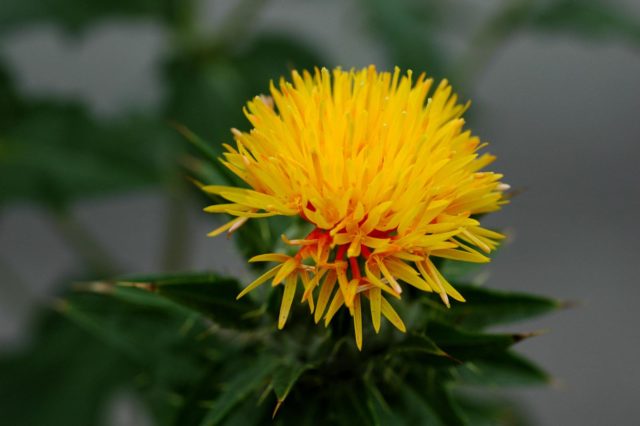
The benefits of safflower petals
The most popular in folk medicine are the petals of dyeing safflower. They contain the maximum amount of vitamins and other beneficial compounds. The flowers are used to prepare a healing tea with diuretic, anti-inflammatory and purifying properties. It is especially recommended to use dye safflower and its petals:
- with slow digestion and frequent constipation;
- with anemia and heart failure;
- with frequent numbness of the limbs;
- with diseases of the stomach and liver;
- with high blood pressure;
- with a tendency to blood thickening.
Dyeing safflower petals in teas and infusions are good for bacterial processes in the throat and mouth. It is useful to use them for gum disease and sore throat.
Preparation and application methods
Traditional medicine uses dye safflower in several forms. Some petal-based products can be prepared on your own, others must be purchased from pharmacies and specialty stores.
Tea, infusion
Infusion on petals, or safflower tea, is prepared from the dried flowers of the plant. The classic recipe looks like this:
- dye safflower petals are ground in a volume of 1/4 of a small spoon;
- the raw material is poured with a glass of hot water - the temperature should be about 80 ° C;
- close the container with a lid and incubate for half an hour;
- after a lapse of time, filtered.
It is recommended to use the infusion on petals once a day in a volume of 250 ml. Tea helps to normalize liver and kidney function, eliminates intestinal infections and strengthens general immunity.
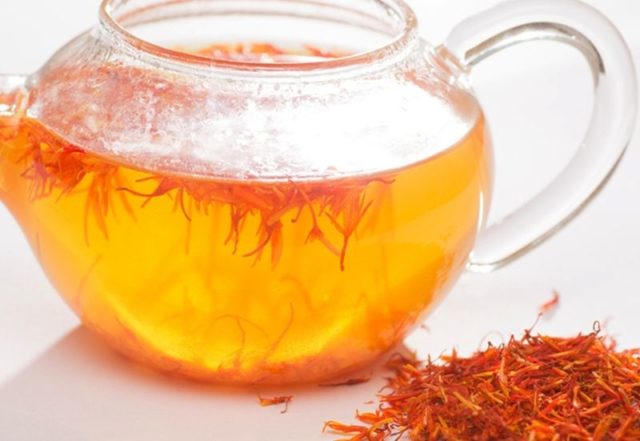
Safflower seeds
Safflower seeds are used after preliminary purification to prepare oil with valuable nutritional and cosmetic properties. It is impossible to create a product at home, since it is obtained on professional equipment after a complex cycle of preparation, grinding and pressing of raw materials. But safflower oil is available in specialized stores.
In cosmetology, it is used in the manufacture of creams, softening masks and cleansing lotions. In its pure form, the oil can be applied to the skin to protect against ultraviolet rays and to eliminate rosacea. The squeeze helps to strengthen the curls and gives them shine and volume, and improves blood flow at the hair roots.
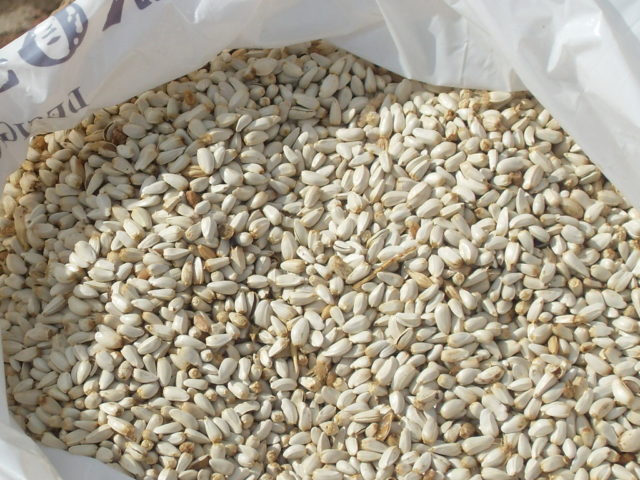
Honey
Dyeing safflower belongs to the category of melliferous plants. At the same time, it is rather difficult to find monofloral nectar of this type - wild saffron blooms profusely for only two weeks and gives good bribes only in warm calm weather. Safflower honey has a light yellow or straw tint that does not change after crystallization, a sweet taste with a slight bitterness, a weak floral aroma and a thick consistency.
The delicacy has pronounced bactericidal properties, is widely used for colds and cardiovascular diseases, as well as in cosmetology - to soften and rejuvenate the epidermis. Safflower honey is used for skin ailments, arthritis and rheumatism, to get rid of insomnia and normalize the emotional background.
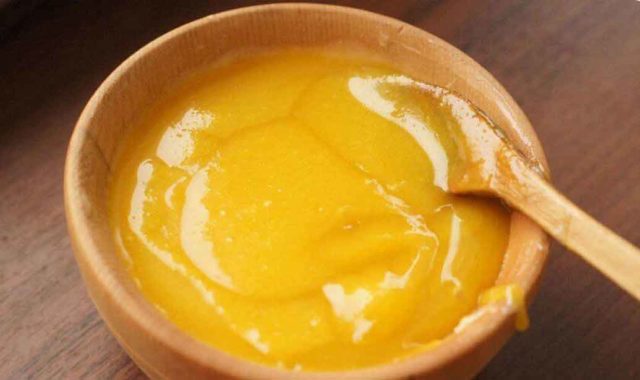
Application in traditional medicine
Traditional medicine advises to use dyeing safflower petals and honey from plant nectar to strengthen the body and for digestive diseases.There are several proven effective recipes.
With edema
Dyeing safflower petals have diuretic properties, so tea based on them helps to get rid of edema. With a retention of fluids in the body and impaired kidney function, you can prepare the following remedy:
- petals in the volume of 1/2 small spoon are poured with a glass of hot water;
- leave tea under the lid to brew for 20-30 minutes;
- filter and cool until warm.
The drink should be taken in the daytime or in the evening, 250 ml, in total, up to two glasses are allowed to drink a day.
For immunity
With a weakened immune system, safflower honey is beneficial. For medicinal purposes, prepare the following drink:
- two small spoons of sweet nectar are poured into a glass of warm water;
- stir until dissolved.
Means from honey dyeing safflower are taken on an empty stomach daily, 250 ml. It is best to drink the solution in the morning, then it will not only strengthen the immune system, but also speed up metabolic processes.
With psoriasis
The beneficial properties of wild saffron are used for skin ailments. The healing petals of the plant in the form of a decoction relieve irritation and help get rid of inflammation in psoriasis. Traditional medicine offers the following recipe:
- 4 liters of filtered water are poured into an enamel pan and brought to a boil;
- add dried petals of dyeing safflower in the volume of a small spoon and simmer over low heat for five minutes;
- removed from the stove and cooled.
The filtered agent is taken in a glass up to four times a day.
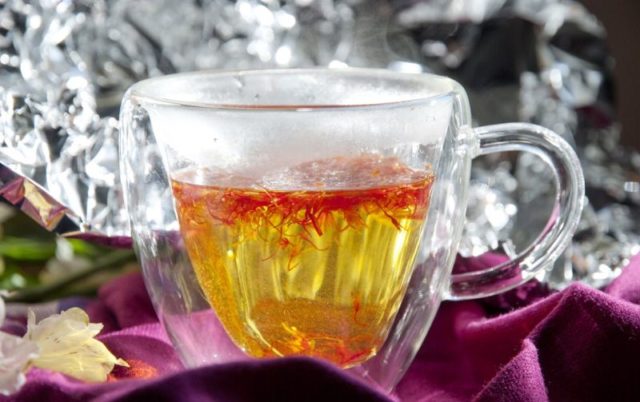
With gastritis
The anti-inflammatory and healing properties of dye safflower are beneficial for chronic gastritis. To restore mucous membranes and normalize digestion, you can prepare the following remedy:
- dried petals are poured into a thermos in the amount of two small spoons;
- raw materials are poured with 250 ml of hot water;
- close the container and leave to infuse for an hour;
- filter.
It is necessary to take an infusion of dye safflower in a glass up to four times a day. The drug is taken on a full stomach.
Slimming application
You can use safflower oil to get rid of those extra pounds. It cleanses the blood and helps to remove toxins and toxins from the body, prevents the development of constipation and speeds up metabolism.
In the process of losing weight, oil is taken in the amount of two small spoons per day along with healthy low-calorie food. The first results become noticeable after a week of using the product. Especially quickly safflower oil helps to lose weight, if you pay extra attention to sports exercises and adhere to the daily regimen.
Application in cosmetology
Infusions of dyeing safflower and seed oil are used in the cosmetic field. With proper use, the plant moisturizes the epidermis and eliminates minor inflammations, smoothes first wrinkles and improves complexion. Seed oil is added to homemade masks or finished beauty products. At the same time, it is introduced in small quantities - no more than 30% of the total volume.
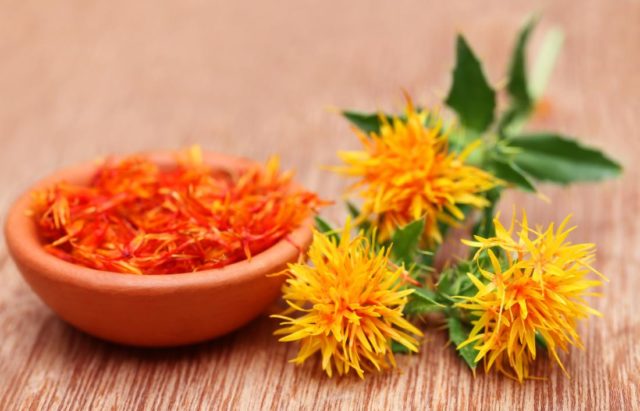
Dyeing safflower has a beneficial effect on curls. It prevents strands from falling out and accelerates their growth, making hair silky and manageable. It is allowed to rinse the head after washing with the infusion of petals, in addition, you can add oil from the seeds to a regular shampoo. The dosage is 15 ml per 100 g of care product.
Cooking applications
Safflower petals are used in the food industry as a safe red, yellow or orange dye. You can meet the plant mainly as part of confectionery. In addition, dried petals are added to dishes as an alternative to saffron, seasoning with them meat, fish and poultry.
Dyeing safflower oil can be used to season salads. In the East, squeezing seeds is popular in the preparation of hot dishes. It has little smoke and is great for deep-fried food.
Contraindications to the use of safflower
The medicinal properties of the safflower herb are combined with contraindications. In some conditions, the plant in any form must be discarded. It is not recommended to use safflower petals and seeds:
- during pregnancy;
- during the feeding period;
- with renal failure;
- with a tendency to uterine and hemorrhoidal bleeding;
- with frequent diarrhea and increased intestinal peristalsis;
- with individual allergies.
Although dye safflower is considered to be a fairly safe plant, it is necessary to adhere to the dosages indicated in the recipes when using it. If consumed in excess, teas and infusions of petals can cause dehydration and indigestion.
Collection and procurement
It is necessary to collect the petals of the dyeing safflower during the decorative period of the plant - in June and July. Harvesting is carried out on a warm day without precipitation, preferably before noon.
The collected raw materials are laid out for drying under a canopy or indoors with good ventilation. Direct rays of the sun should not fall on the petals. Dryers and ovens for processing raw materials should not be used, since even a slight increase in temperature can lead to the destruction of valuable substances in the composition. One of the harvesting methods suggests tying the collected dye safflower into small bunches and hanging them from the ceiling with the inflorescences down. In this case, the petals do not have to be constantly agitated for uniform drying.
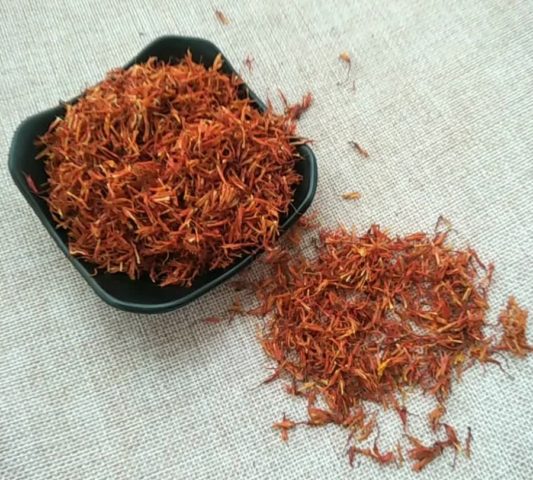
The harvested flowers are stored in paper bags or cloth bags in a dark place with low humidity.
Conclusion
The beneficial properties of safflower petals are used to improve digestive processes and strengthen immunity. There are few contraindications for the plant, however, when using teas, infusions and valuable oil, small dosages must be observed so as not to encounter dehydration and gastric disorders.

